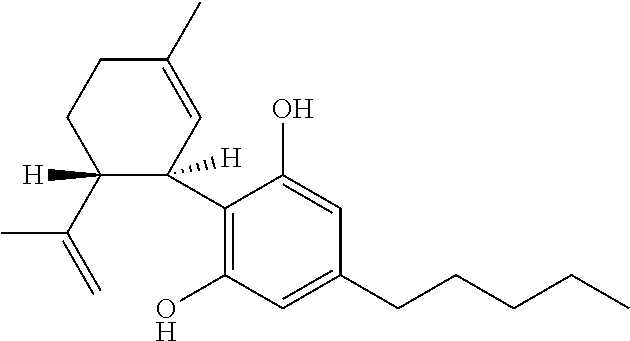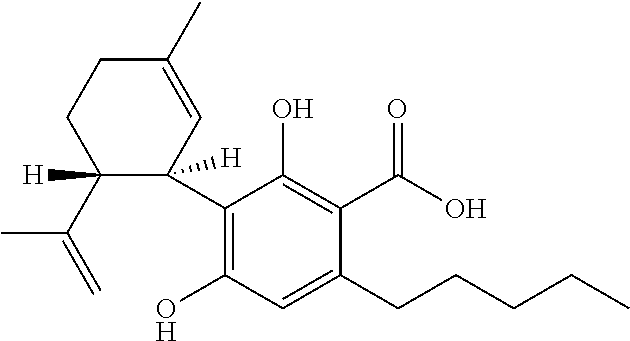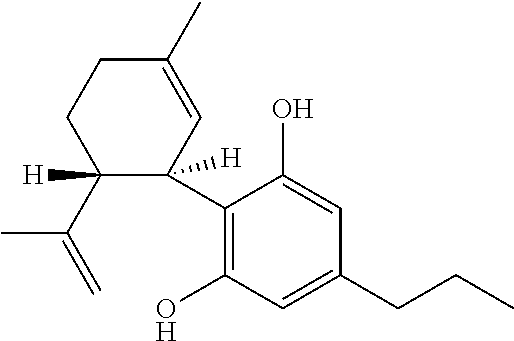Use of cannabinoids in the treatment of epilepsy
a cannabinoid and epilepsy technology, applied in the field of cannabinoids in the treatment of epilepsy, can solve the problems of difficult treatment, inability to obtain seizure freedom, cognitive, behavioral and motor delays, etc., and achieve the effect of reducing seizures
- Summary
- Abstract
- Description
- Claims
- Application Information
AI Technical Summary
Benefits of technology
Problems solved by technology
Method used
Image
Examples
example 1
Interaction Between Cannabidiol (CBD) and Stiripentol (STP) During a Clinical Trial
[0051]The efficacy of CBD for the adjunctive treatment of seizures associated with Dravet syndrome was demonstrated in a single trial in patients aged 2-18 years. Following completion of a 4-week baseline period, patients were randomized to receive either 20 mg / kg / day CBD (n=61) or placebo (n=59). CBD or placebo were added to their current anti-epileptic treatment which remained stable over the treatment period of the study.
[0052]All patients had a diagnosis of treatment-resistant Dravet syndrome and seizures were inadequately controlled with one or more concomitant anti-epileptic drugs (AEDs) with or without vagal nerve stimulation or ketogenic diet.
[0053]Seizure counts were reported daily via an Interactive Voice Response System. Convulsive seizures were defined as all countable atonic, tonic, clonic, and tonic-clonic seizures. The primary efficacy end point was percent change from baseline in convu...
example 2
Interaction Between Cannabidiol (CBD) and Stiripentol (STP) in Healthy Volunteers
[0067]As part of an open-label, fixed sequence, healthy volunteer trial the primary objective was to investigate the impact of CBD (750 mg twice daily) on the steady-state pharmacokinetics of stiripentol (STP) (750 mg) and the reciprocal effect on CBD, 7-hydroxy-cannabidiol (7-OH-CBD) and 7-carboxy-cannabidiol (7-COOH-CBD).
[0068]Analyte plasma concentrations were determined using validated bioanalytical methods. A secondary objective was to evaluate the safety and tolerability of CBD when co-administered with STP.
[0069]When CBD was combined with STP (12 subjects) there was a 1.28- to 1.55-fold increase in exposure (Cmax and AUCtau). Co-administration of STP with CBD had no effect on CBD exposure; however, STP reduced 7-OH-CBD and 7-COOH-CBD exposure by 29% and 13% respectively.
[0070]The most common adverse event (AE) was diarrhoea, none of the effects on analyte exposure observed were likely to be clini...
PUM
| Property | Measurement | Unit |
|---|---|---|
| w/w | aaaaa | aaaaa |
| w/w | aaaaa | aaaaa |
| w/w | aaaaa | aaaaa |
Abstract
Description
Claims
Application Information
 Login to View More
Login to View More - R&D
- Intellectual Property
- Life Sciences
- Materials
- Tech Scout
- Unparalleled Data Quality
- Higher Quality Content
- 60% Fewer Hallucinations
Browse by: Latest US Patents, China's latest patents, Technical Efficacy Thesaurus, Application Domain, Technology Topic, Popular Technical Reports.
© 2025 PatSnap. All rights reserved.Legal|Privacy policy|Modern Slavery Act Transparency Statement|Sitemap|About US| Contact US: help@patsnap.com



